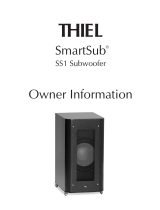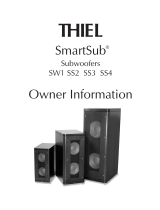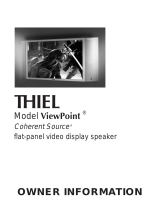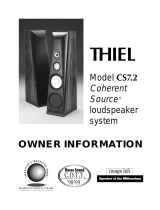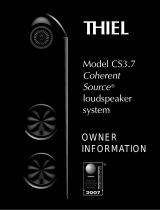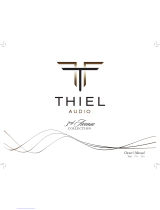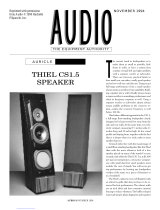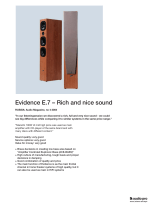Page is loading ...

What defines the perfect loudspeaker? Thiel Audio founder Jim T h i e l
would say that a loudspeaker must possess a c c u r a c y, in the
broadest sense of the term. In other words, a loudspeaker should
have linear frequency response, low distortion, and perfect time
and phase alignment, or c o h e r e n c e. Although many loudspeaker
designers will cite low distortion and linear response as goals, very
few consider time and phase alignment critical to the overall sound.
Some believe the cost of implementing such technology far exceeds
the payoff, while others think the human ear is insensitive to the
difference between coherent and noncoherent loudspeakers.
Thiel’s website offers scientific data to the contrary. Their Coherent
Source (CS) technology is one of the hallmarks of the Kentucky-
based company’s design philosophy. Thiel Audio doesn’t appear to
rely on pseudoscience or unsupported claims. The company claims
to be driven by research and development steeped in physics and
the scientific method.
Six Thiel speakers costing a total of $14,700 arrived on my doorstep.
The MCS1 ($2300) and pairs of CS2.4s ($4400/pair) and PowerPoints
($1300 each) didn’t bear much of a family resemblance (until I
looked at their drivers). The SS2 subwoofer ($4900) handled the low
bass, and Thiel’s PX05 passive five-channel crossover ($500) tied
everything together.
Coherent construction
Tight tolerances, flawless finishes, and hand-matched Amberwood
veneers result in the elegant and sophisticated appearance of the
CS2.4, MCS1, and SS2. Hyper-accurate CNC machines cut the MDF
parts of each hand-assembled enclosure. The PowerPoint’s thick,
alabaster-like ABS plastic shell is thermoformed, while its trapezoidal
shape keeps the driver’s baffle as close to the wall as possible.
According to Thiel, their Coherent Source technology ensures perfect
time and phase alignment between a speaker’s drivers. The CS2.4
and MCS1 use a 1" aluminum tweeter coincidently mounted to a
3.5" aluminum midrange cone. Jim Thiel prefers the term c o i n c i d e n t
to coaxial because proper time alignment requires that a driver’s
acoustic center outputs from the same geometric plane. While coaxial
drivers share the same axis, coincident drivers share the same axis
a n d plane. Thiel designs coincident drivers to be perfectly coherent
across their frequency range. The drivers are coupled with a tuned
mechanical suspension instead of a traditional crossover, which,
Thiel maintains, avoids distortion.
The bass frequencies must also remain in time and in phase with
the midrange and tweeter outputs. Because different frequencies
travel through air at the same velocity, the arrival times of individual
drivers’ waveforms will be offset if their acoustic centers are not in
the same vertical plane; the result, according to Thiel, is a poorly
defined image. The CS2.4’s slanted baffle guarantees that the audio
waveforms from the 3.5" coincident driver and the robust 8" aluminum
woofer arrive at the listener’s ears at the same time. And the CS2.4’s
first-order, phase-corrected crossover ensures that the waveforms
arrive simultaneously at the listening position.
The MCS1 center speaker also uses a first-order, phase-correct
c r o s s o v e r. However, this speaker’s flat baffle relies on two shallow,
6.5", polystyrene-reinforced aluminum woofers to keep low-frequency
output in the same plane, and therefore time-aligned, with the
coincident driver. The shallow woofers also allow the coincident driver
to be flush-mounted to the baffle, thus reducing the effects of cabinet-
edge diffraction on sound dispersion.
The PowerPoint surround speaker’s coincident driver is a 1" aluminum
tweeter coupled to a 6.5" woofer cone. The driver’s dispersion
emerges at 90 degrees to the center of the tweeter, which, together
with the 45-degree baffle, directs output away from the adjoining
wall. According to Thiel, this prevents signal cancellation in the critical
midrange frequencies.
Although the SS2 subwoofer’s two 10" aluminum cones and compact,
room-friendly enclosure look conventional for a subwoofer, the SS2 lacks
the standard phase, gain, and crossover controls. Jim Thiel’s extensive
research has convinced him that room boundaries and dynamic
compression due to voice-coil heating are the two main things that
December 2004
Product Review
Thiel A u d i o
CS 2.4 / MCS1 / PowerPoint / SS2 / PX05
Home-Theater Speaker System
By: Anthony DiMarco
© Schneider Publishing Inc.
w w w . h o m e t h e a t e r s o u n d . c o m

affect subwoofer performance; he claims that the crossover and
phase controls available on most subs harm the subs’ f r e q u e n c y
response and integration with a set of main speakers. T h i e l ’ s
SmartSub technology purportedly addresses all of these issues. A
1000W class-D amplifier supplies the grunt expected from a high-
quality sub. The SS2 is designed to work with T h i e l ’ s two-channel PX02
and five-channel PX05 passive crossovers, or the SI 1 Integrator
electronic controller.
Coherent setup
The CS2.4’s four poorly glued floor-spike inserts and the PowerPoint’s
easy-to-strip Sheetrock mounting anchors were the only problems
I experienced during setup. Thiel’s Shari Graham had a bottle of
adhesive on my doorstep the next day, and assured me that she
would discuss my Sheetrock-anchor issue with their parts buyer.
Such prompt attention reinforces the benefit of purchasing from
a company of T h i e l ’ s dedication and experience: Unlike the
functionaries who work for many faceless conglomerates, Ms.
Graham is empowered to solve customer issues on the spot. I
experienced the same high level of customer service from Thiel with
a used pair of CS1.2s I bought years ago, before I began writing
r e v i e w s .
I hooked up my Analysis Plus T1 spade lugs to the CS2.4s’ g o r g e o u s ,
well-spaced binding posts. The deeply knurled nuts easily clamped
down on the meaty spades. I immediately noticed that the 3.5"
drivers performed equally well horizontally and vertically off - a x i s .
Many speakers with a separate tweeter and midrange lose high-
frequency sparkle and clarity when listened to from an angle and
not at ear height. Thiel’s 3.5" coincident driver did not have this
problem. The CS2.4s were much easier to place than my CS1.2s
had been. I was able to listen to music without sonic degradation
while playing on the floor with my son.
The MCS1 center speaker produced the same sort of fantastic off-
axis sound. I first mounted the 60-pound speaker to a T h i e l - s u p p l i e d
Sound Anchor stand, but my wife and I agreed that the heavy steel
stand took up too much floor space and clashed with the room’s
décor. So we set the MCS1 on a piece of plywood atop our TV. The
sound quality and tonal balance remained transparent—the MCS1
produced uniform frequency response no matter where I or it sat.
My living area has its share of sonic challenges. My couch sits up
against a wall, which makes placement of surround speakers tricky.
I sent digital photos of my room to Thiel, who recommended mounting
the PowerPoints on the sidewall within a foot of the rear wall, pointed
down toward my listening position. I placed the PowerPoints about
8" from the ceiling, which resulted in an open, nonlocalized surround
fill. The SS2 subwoofer took its place at the far end of my couch,
firing across the CS2.4s’ soundstage.
The SS2 has a single-ended RCA connection for LFE input and a
balanced XLR connection for interfacing with the PX05 passive
crossover. Both connections also have a pass-through so multiple
SS2s can be daisy-chained. The extremely well-built PX05 crossover
takes high-level signals from either the speakers’ terminals or an
a m p l i f i e r’s output and modulates them into a single, balanced,
line-level signal that feeds the SS2. Although the PX05’s binding
posts are of very high quality, they’re too close together for spade
lugs; banana plugs worked much better. The LFE signal came
directly from my McCormack MAP-1 preamplifier’s subwoofer output.
The SS2 has a simple three-button LED interface. One button selects
each of the sub’s two settings, while the others adjust the settings
up or down. The first setting is for LFE level. The second goes to the
heart of T h i e l ’ s SmartSub design philosophy: boundary compensation .
According to Thiel, the SS2’s microprocessor-controlled a n a l o g
signal processing programs the distance between the sub and two
surrounding walls, and cancels out the negative effects of a room’s
boundaries on the bass response. It took me two minutes to measure
and input the distances. What I heard after that was miraculous.
Coherent bliss
The Triplets of Belleville is a beautifully crafted animated film with
a bittersweet storyline. The film is almost devoid of dialogue, relying
instead on gestures and expression to define character and plot.
The sound design exhibits the same stellar craftsmanship — detail,
ambience, and unexpected dynamics abound. Chapters 6-8 drenched
me in the sounds of rain, subtle taps, whispers, and the bark of an
annoyed dog as a train rushes by. The Thiel system’s universally
brilliant high- and mid-frequency reproduction rendered with energy
and lush harmonic color this quirky world of a French cyclist and
his protective Grandma.
I have heard other systems demonstrate a seamlessly consistent
surround image, but I always get the sense that transducers are
reproducing the image. The Thiels took this behavior to the next
level by creating a 5.1 image that was so lucid, so composed, that I
forgot that there were loudspeakers in the room. The six T h i e l
speakers truly spoke with one voice.
I had no problem suspending my disbelief during the helicopter
crash and subsequent shoot-out in chapters 9 and 10 of Black Hawk
D o w n. The recently released Superbit version offers an excellent DTS
mix that wraps around the listener and drives home the concussive,
unpredictable experience of battle. Speakers that lack focus and
control can lose their way with such heavily layered soundtracks.
But the Thiels never sounded veiled, or lacked definition or impact.
Loud, soft, or tightly packed — all sounds remained absolutely clear
during even the most chaotic scenes.
The SACD of Peter Gabriel’s Up [Geffen 493388] is an excellent
test of bass-management transparency. The voice, instruments,
and bass are sent to discrete channels rather than being mixed to
all, making it easy to pick up on any crossover inconsistencies.
If the bass doesn’t seamlessly transition from a system’s main
PAGE 2
© Schneider Publishing Inc.
w w w . h o m e t h e a t e r s o u n d . c o m

PAGE 3
© Schneider Publishing Inc.
w w w . h o m e t h e a t e r s o u n d . c o m
speakers to the sub, "Growing Up" or "The Barry Williams Show"
will reveal that sub’s relative position. The SS2 and PX05 did a
fantastic job of convincing me that the deep bass was anchored to
each speaker.
The PowerPoint surrounds sounded bigger and the CS2.4s delivered
more authoritative bass when the SS2 was added. The massive
drum strokes on Kodo’s "Daraijin," from Mondo Head [SACD, Red
Ink/Sony 56111], appeared from behind me with surprising weight
and slam. Experiencing the T h i e l s ’ impressive integration was
exhilarating with film soundtracks and music alike. I had never
heard a speaker system that disappeared quite as the Thiels did,
or a subwoofer that performed as transparently as did the SS2.
I was never left wanting for the bracing dynamics of Copland’s
Appalachian Spring Suite, from Eiji Oue and the Minnesota Orchestra’s
S h o w c a s e [CD, Reference RR- 907CC], or Leonard Bernstein’s adoring
interpretation of Mahler’s Symphony 3 [CD, Deutsche Grammophon
427 328-2]. Brass and cymbals always sounded pure and extended,
with a nice balance of shimmer and controlled decay.
The T h i e l s ’ utter lack of coloration and outstanding three-dimensional
imaging made the hair on the back of my neck stand up on end
countless times. Every sound remained anchored in physical space.
The well-recorded score of M. Night Shyamalan’s The Village [CD,
Hollywood 162464], and such pop recordings as Seal’s newest
DVD-Audio release, Seal IV [ Warner Bros. 47947], sounded
wonderfully rich and intoxicatingly sweet through the Thiels,
while the system’s considerable speed and resolution made me
tap my foot to the desperate melodies and pulsating bass lines of
synthesizer wizard BT’s "Lullaby for Gaia," from E S C M [ C D ,
Reprise 46799].
Coherent competition?
I have been very happy with my Canton Ergo home-theater speaker
system. At a little over $5500, the Canton system provides an
exciting music and home-theater experience at not much more
than a third of the Thiels’ price. The three-way Ergo RC-A is an
incredible bargain; this big speaker’s built-in powered subwoofer
gives it a huge advantage when space is at a premium, with none
of the integration challenges of a standalone sub. And Canton’s
exclusive room-compensation circuit makes speaker placement a
snap. The subs, coupled with the passive driver’s speed, deliver
breathtaking dynamic impact.
The Thiels sounded considerably more refined and coherent than
the Canton Ergos. Although transparent, the Cantons can get a bit
edgy in the upper midrange, a little lightweight in the upper bass.
They also sound a bit unfocused in the low mids and upper bass. T h e
Thiels, however, always sounded smooth and natural across their
response curve. In terms of imaging, the difference between the
two systems is the difference between the accomplished and the
merely competent. The Cantons produce a wide but relatively
shallow soundstage; the Thiels countered with unbelievably composed
and uniformly dense images that extended both in front and to the
rear of the speakers’ baffles — no matter how far apart they were
placed or how loudly they were played.
Bass was where the two systems almost met. Alone, the CS2.4s
produced pure, effortless bass that reached deeper than I would
have expected from speakers of their size. With the SS2 sub, that
bass had more harmonic weight and was perfectly controlled and
extended. The RC-As’ built-in subs offer as much detail and control
as the CS2.4s, but can’t produce quite the level of harmonic
integrity or extension of the CS2.4s plus SS2.
The MCS1 and PowerPoint simply outclassed Canton’s Ergo CM 500
DC center-channel and Ergo F surround speakers. T h i e l ’s coincident
driver enabled the MCS1 and PowerPoints to remain rock-solid off -
axis when compared to the Ergo CM 500 DC’s smaller midrange-
tweeter-midrange design and the Ergo F’s standard two-way array.
Size gave the MCS1 the edge over the CM 500 DC in terms of bass
extension and weight, while the Ergo Fs couldn’t muster the
PowerPoints’ bass detail and refinement.
The Cantons did exhibit a little more high-frequency bite, though by
b i t e I don’t mean extension or detail, but snap and shimmer. T h e
crash of cymbals and the swell of orchestra were a touch more
exciting through the Cantons. Although this could be considered a
slight distortion of the music, it did get my blood moving without
inducing listening fatigue.
While the Ergo RC-A costs about the same as the CS2.4, keep in
mind that the MCS1 is more than twice the price of the CM 500 DC,
and a pair of PowerPoints costs about four times as much as a pair
of Ergo-Fs. So while it’s easy to hear major improvements through
the Thiels, the complete Canton system does a nice job of making
music with perfectly integrated bass for a much lower price.
Coherence concluded
I spoke to Jim Thiel several times while researching this system, and
there was no denying the passion with which he approaches his
work. He explained with boundless enthusiasm his unique design
philosophy and methodology, describing in great detail every
nuance, every nut and bolt. Each question I asked was answered
with an overabundance of description. His grasp of science was as
obvious as his love of music.
The Thiel speakers reviewed here made beautiful music. Their sound
wasn’t sweet or warm or exciting; rather, it expressed whatever
sweetness, warmth, or excitement was contained in the recording.
T h i e l ’s Coherent Source technology has forever changed my
perception of what a great loudspeaker system should accomplish,
especially in terms of subwoofer integration and the stability of both
two-channel and surround-sound images. Is this Thiel system a
Reviewers' Choice? Absolutely.

PAGE 4
Home Theater & Sound is part of the SoundStage! Network
Published by:
Schneider Publishing Inc.
Box 20068, 390 Rideau Street,
Ottawa, ON K1N 9N5
Canada
© Schneider Publishing Inc.
w w w . h o m e t h e a t e r s o u n d . c o m
Model: CS2.4 MCS1 PowerPoint SS2 PX05
Floorstanding Center-Channel Surround Powered Five-Channel
Speaker Speaker Speaker Subwoofer Passive Crossover
Dimensions: 41.5"H x 28.5"W x 19.75"W x 23.5"H x 2"H x
11"W x 14"D 10"H x 12.5"D 12.25"H x 5.5"D 11"W x 20"D 7"W x 6.5"D
Weight: 140 pounds/pair 61 pounds 5 pounds 108 pounds 3 pounds
Price: $4400 USD/pair $2300 USD $1300 USD $4900 USD $500 USD
System Price: $14,700 USD
Warranty: Ten years parts and labor.
Thiel Audio
1026 Nandino Boulevard
Lexington, KY 40511-1207
Phone: (859) 254-9427
Fax: (859) 254-0075
E-mail: [email protected]
Website: www.thielaudio.com
Review System
Speakers: Canton Ergo RC-A (mains), Ergo CM 500 DC (center), Ergo F (surrounds)
Preamplifier: McCormack MAP-1
Crossover: Outlaw ICBM
Amplifier: Audio Research 150M.5
Sources: Esoteric DV-50 universal audio/video player
Cables: Analysis Plus, Stereovox
M o n i t o r : Mitsubishi WT-46809 rear-projection widescreen monitor with Duvetyne modification and full ISF calibration
Power Conditioning: Panamax, Shunyata Research
Features:
Coherent Source design
(CS2.4, PowerPoint,
MCS1)
Coincident driver array
(CS2.4, PowerPoint,
MCS1)
Metal-diaphragm woofers
(all)
Uniform Resistive Load
improves performance
with lower-powered
amplifiers (CS2.4,
PowerPoint, MCS1)
Available in a variety of
stock and custom finishes
(CS2.4, MCS1, SS2)
Patented SmartSub
technology (SS2)
1000W class-D
amplifier (SS2)
Boundary-compensation
circuit
Circuitry that compensates
for compression distortion
due to voice-coil heating
(SS2)
Choice of Thiel SI 1
Integrator electronic
crossover or PX02 or
PX05 passive crossover
/

